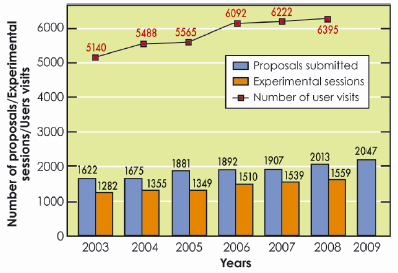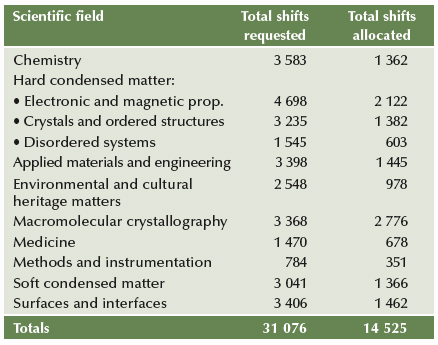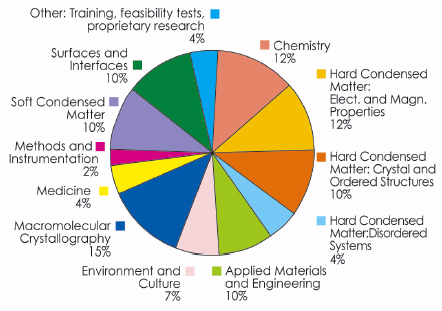User operation
After 15 years of successful operation of the facility for Users, we look back on user operation over the last year, 2009. As has been the case since midway through 2005, we once again saw the full complement of 31 public beamlines, together with 11 additional beamlines operated by Collaborating Research Groups (CRGs), available for experiments by visiting research teams. Figure 165 shows the ever-increasing number of applications for beamtime received since 2003, confirming that, despite the completion of the original beamline construction programme at ESRF and the fact that more synchrotrons are now available to European scientists, there is a constantly increasing demand for use of the ESRF beamlines. The number of applications for beamtime broke through the 2000 barrier for the first time in 2008 and continued to rise still further in 2009.
 |
|
Fig. 165: Number of applications for beamtime, experimental sessions and user visits, 2003 to 2009. N.B. Final numbers of experimental sessions and user visits for 2009 were not available at the time of going to press. |
Proposals for experiments are selected and beamtime allocations are made through peer review. Review Committees of specialists, for the most part from European countries and Israel, have been set up in the following scientific areas:
- chemistry
- hard condensed matter: electronic and magnetic properties
- hard condensed matter: crystals and ordered systems
- hard condensed matter: disordered systems and liquids
- applied materials and engineering
- environmental and cultural heritage matters
- macromolecular crystallography
- medicine
- methods and instrumentation
- soft condensed matter
- surfaces and interfaces.
The Review Committees met twice during the year, around six weeks after the deadlines for submission of proposals (1 March and 1 September). They reviewed a record number of 2047 applications for beamtime, and selected 929 (45.4 %), which were then scheduled for experiments.
Features of this period:
- a significant increase in the number of macromolecular crystallography (MX) rolling proposals submitted between the April and October 2009 proposal rounds – nearly 80 proposals were received and reviewed on a continuous basis under this scheme. This is mainly due to an increase in the number of proposals for the new bio-SAXS beamline, ID14-3, but also includes a significant number of proposals for online spectroscopy experiments.
- once again, in the area of Soft Condensed Matter, around half of all proposals submitted were concerned with biomaterials.
Requests for beamtime, which is scheduled in shifts of 8 hours, totalled 31 076 shifts or 248 608 hours in 2009, of which 14 525 shifts or 116 200 hours (46.7%) were allocated. The distribution of shifts requested and allocated, by scientific area, is shown in Table 9.
 |
|
Table 9: Number of shifts of beamtime requested and allocated for user experiments, year 2009. |
The breakdown of shifts scheduled for experiments by scientific area in the first half of 2009 is shown in Figure 166. This same period saw 3268 visits by scientists to the ESRF under the user programme, to carry out 809 experiments. Overall, the number of users in each experimental team averaged four persons as in 2008, and the average duration of an experimental session was 9.6 shifts compared with 10.1 shifts in 2008. This can be further broken down to show an average duration of 3.4 shifts for MX experiments and 13.9 shifts for non-MX experiments. Compared with the 2008 figures (3.4 shifts and 15.0 shifts respectively), this indicates that non-MX experiments have tended to become shorter thanks to many factors including higher automation and increased flux from state-of-the-art optics. This is also reflected in the constant rise in the annual number of experimental sessions and user visits since 2003 as shown in Figure 165, as shorter and therefore more frequent experiments become possible across almost all scientific areas.
 |
|
Fig. 166: Shifts scheduled for experiments by scientific area for a total of 7809 shifts, scheduling period 2009/1, March to July 2009. |
User responses to questionnaires show once again that the ESRF continues to maintain its excellent reputation concerning the assistance given by scientists and support staff on beamlines, and travel and administrative arrangements, in addition to the quality both of the beam and of the experimental stations. Facilities on site, such as preparation laboratories, the Guesthouse and a canteen open seven days a week, also make an important contribution to the quality of user support.
J. McCarthy



